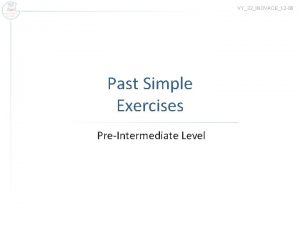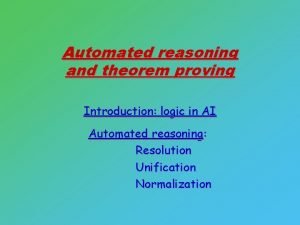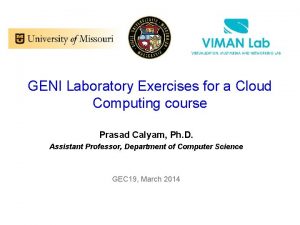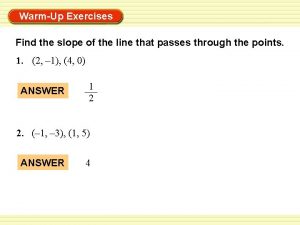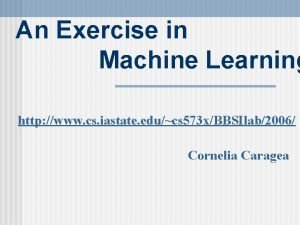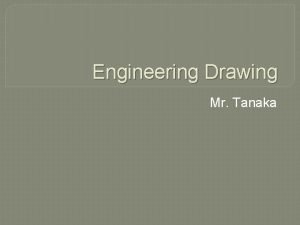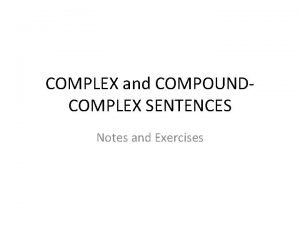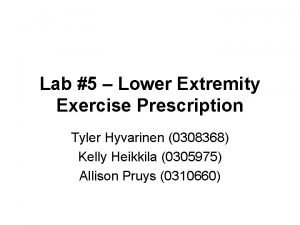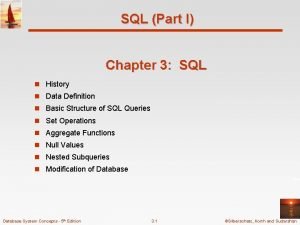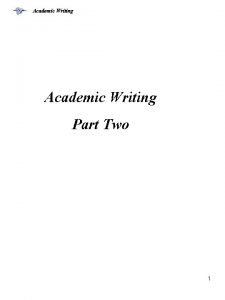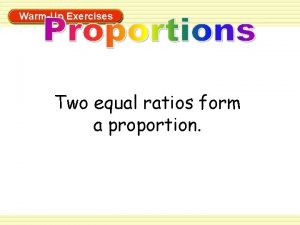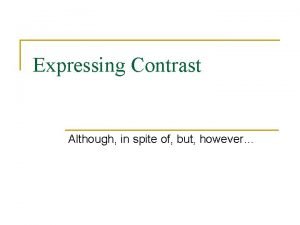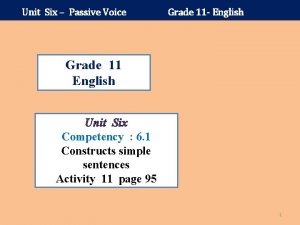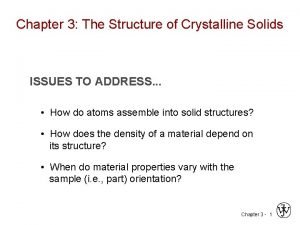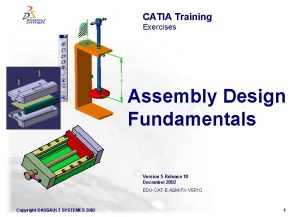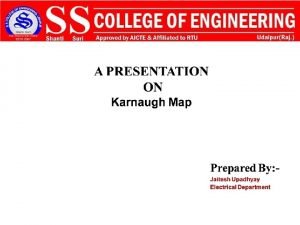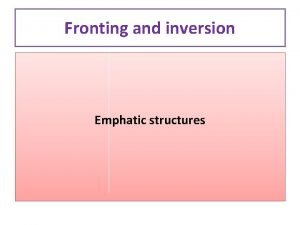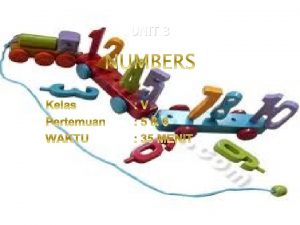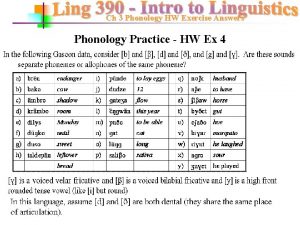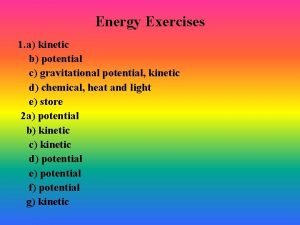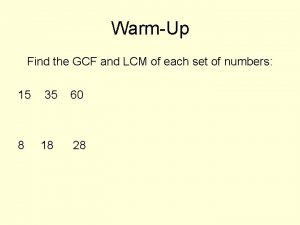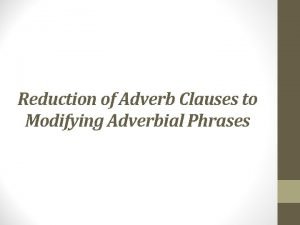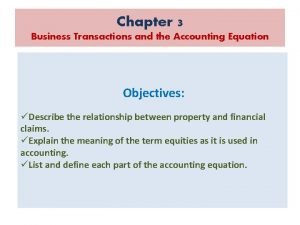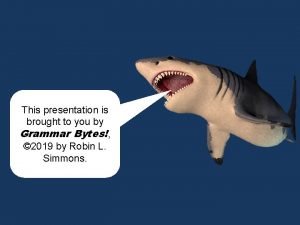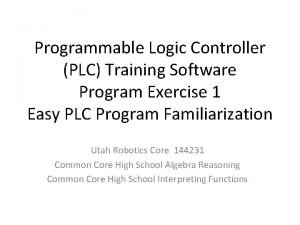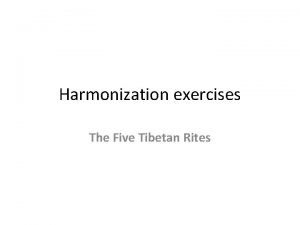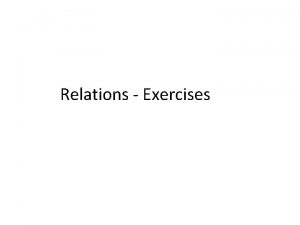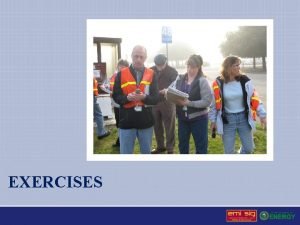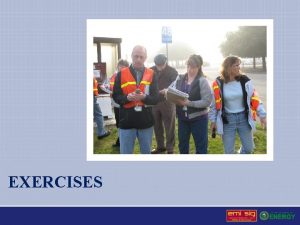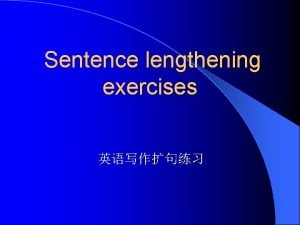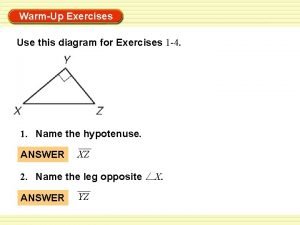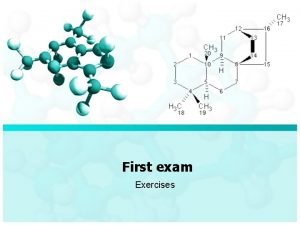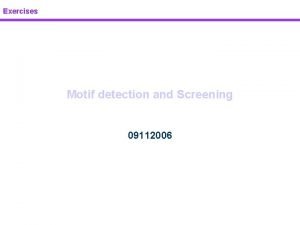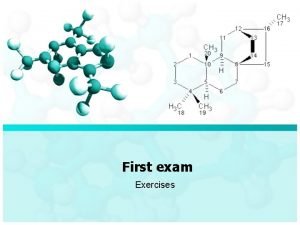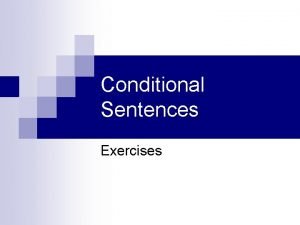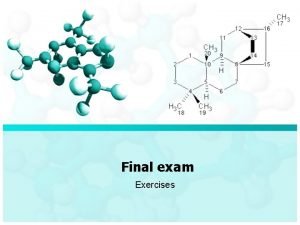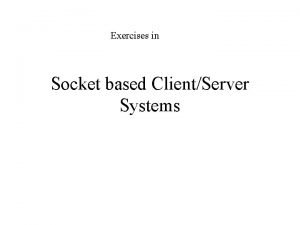Exercises 2 Exercise 2 1 Exercise 2 1
























































- Slides: 56

Exercises 2

Exercise 2. 1

Exercise 2. 1 10. 3 cm 0. 461 cm 1. 13 m. L/min 61%

Exercise 2. 1 10. 3 cm 0. 461 cm 1. 13 m. L/min 61%

Exercise 2. 1 10. 3 cm 0. 231 cm 0. 461 cm 1. 13 m. L/min 39% 61% The inner volume of the column is πr 2·L V = π · 0. 2312 cm 2 · 10. 3 cm = 1. 72 cm 3 Mobile phase volume is 1. 72 · 0. 39 = 0. 670 cm 3

Exercise 2. 1 10. 3 cm 0. 231 cm 0. 461 cm 1. 13 m. L/min 39% 61% The inner volume of the column is πr 2·L V = π · 0. 2312 cm 2 · 10. 3 cm = 1. 72 cm 3 Mobile phase volume is 1. 72 · 0. 39 = 0. 670 cm 3 The fraction of the column that is swept by the mobile phase each minute is 1. 13 cm 3/min / 0. 670 cm 3 = 1. 69 min– 1 · 10. 3 cm = 17. 4 cm/min

Exercise 2. 1 10. 3 cm 0. 231 cm 0. 461 cm 1. 13 m. L/min 39% 61% can also calculate The inner volume of the column is. You πr 2·L without V = π · 0. 2312 cm 2 · 10. 3 cm = 1. 72 cm 3 the column length. 3 flow (1. 13 cm 3) by the Mobile phase volume is 1. 72 · 0. 39 = Divide 0. 670 cm the cross section surface The fraction of the column that is swept by the mobile phase each minute is area covered by the mobile 1. 13 cm 3/min / 0. 670 cm 3 = 1. 69 min– 1 phase (π∙r 2∙ 0. 39) 1. 69 min– 1 · 10. 3 cm = 17. 4 cm/min

Exercise 2. 1 10. 3 cm 0. 231 cm 0. 461 cm 1. 13 m. L/min 39% 61% In packed columns you cannot calculate the linear velocity without knowing how much of the column volume that is occupied by the stationary phase!

Exercise 2. 1 10. 3 cm 17. 4 cm/min

Exercise 2. 1 10. 3 cm 17. 4 cm/min An unretained solute travels with the same speed as the mobile phase 10. 3 cm / 17. 4 cm/min = 0. 593 min

Exercise 2. 1 10. 3 cm 17. 4 cm/min

Exercise 2. 1 10. 3 cm 17. 4 cm/min k = t′R / t. M Eq. 1

Exercise 2. 1 10. 3 cm 17. 4 cm/min k = t′R / t. M t′R = k · t. M

Exercise 2. 1 10. 3 cm 17. 4 cm/min k = t′R / t. M t′R = k · t. M = 10 · 0. 593 min = 5. 93 min

Exercise 2. 1 10. 3 cm 17. 4 cm/min k = t′R / t. M t′R = k · t. M = 10 · 0. 593 min = 5. 93 min t. R = t′R + t. M = 5. 93 min + 0. 593 min = 6. 53 min

Exercise 2. 2

Exercise 2. 2 0. 53 mm 3. 1 μm 30. 1 m

Exercise 2. 2 0. 53 mm 3. 1 μm 30. 1 m

Exercise 2. 2 0. 53 mm 3. 1 μm 30. 1 m An unretained compound travels 30. 1 m in 2. 16 min u = 30. 1 m / 2. 16 min = 13. 9 m/min = 23. 2 cm/s

Exercise 2. 2 0. 53 mm 3. 1 μm 30. 1 m An unretained compound travels 30. 1 m in 2. 16 min u = 30. 1 m / 2. 16 min = 13. 9 m/min = 23. 2 cm/s The cross sectional area of the tube is πr 2 = 3. 14 · (0. 530/2)2 = 0. 221 mm 2 = 2. 21· 10– 3 cm 2

Exercise 2. 2 0. 53 mm 3. 1 μm 30. 1 m An unretained compound travels 30. 1 m in 2. 16 min u = 30. 1 m / 2. 16 min = 13. 9 m/min = 23. 2 cm/s The cross sectional area of the tube is πr 2 = 3. 14 · (0. 530/2)2 = 0. 221 mm 2 = 2. 21· 10– 3 cm 2 V / t = A · u = 2. 21· 10– 3 cm 2 · 1390 cm/min = 3. 07 cm 3/min

Exercise 2. 2 0. 53 mm 3. 1 μm 30. 1 m An unretained compound travels 30. 1 m in 2. 16 min u = 30. 1 m / 2. 16 min = 13. 9 m/min = 23. 2 cm/s The cross sectional area of the tube is πr 2 = 3. 14 · (0. 530/2)2 = 0. 221 mm 2 = 2. 21· 10– 3 cm 2 V / t = A · u = 2. 21· 10– 3 cm 2 · 1390 cm/min = 3. 07 cm 3/min

Exercise 2. 2 0. 53 mm 3. 1 μm 30. 1 m k= t. R′ t. M

Exercise 2. 2 0. 53 mm 3. 1 μm 30. 1 m k= t. R′ t. R – t. M = t. M

Exercise 2. 2 0. 53 mm 3. 1 μm 30. 1 m k= t. R′ t. R – t. M 17. 32 – 2. 16 = = = 7. 02 t. M 2. 16

Exercise 2. 2 0. 53 mm 3. 1 μm 30. 1 m k= t. R′ t. R – t. M 17. 32 – 2. 16 = = = 7. 02 t. M 2. 16 F= t. R′ t. R

Exercise 2. 2 0. 53 mm 3. 1 μm 30. 1 m k= t. R′ t. R – t. M 17. 32 – 2. 16 = = = 7. 02 t. M 2. 16 F= t. R′ t. R – t. M 17. 32 – 2. 16 = = = 0. 875 t. R 17. 32

Exercise 2. 2 0. 53 mm 3. 1 μm 30. 1 m Kc = c. S c. M Distribution constant

Exercise 2. 2 0. 53 mm 3. 1 μm 30. 1 m Kc = c. S c. M k= n. S n. M Known from b c= n V

Exercise 2. 2 0. 53 mm 3. 1 μm 30. 1 m Kc = c. S c. M k= n. S n. M Known from b c= n V Kc = k · VM A =k· M VS AS Because the lengths of the phases are the same and V = L∙A (cross section areas)

Exercise 2. 2 0. 53 mm 3. 1 μm 30. 1 m Kc = r. A c. S c. M k= n. S n. M c= n V Kc = k · VM A =k· M VS AS Areas of the cross section of the column: AM = π·r 2 AS ≈ 2πr·df Circumference • phase thickness

Exercise 2. 2 0. 53 mm 3. 1 μm 30. 1 m Kc = r. A c. S c. M k= n. S n. M c= n V Kc = k · VM A =k· M VS AS Areas of the cross section of the column: AM = π·r 2 = π·(530/2)2 = 220 mm 2 AS ≈ 2πr·df = 2π·(530/2) · 3. 1 ≈ 5. 16 mm 2

Exercise 2. 2 0. 53 mm 3. 1 μm 30. 1 m Kc = r. A c. S c. M k= n. S n. M c= n V Kc = k · VM A =k· M VS AS Areas of the cross section of the column: AM = π·r 2 = π·(530/2)2 = 220 mm 2 AS ≈ 2πr·df = 2π·(530/2) · 3. 1 ≈ 5. 16 mm 2 Kc = k · AM 220 = 7. 02 · AS 3. 1 = 300

Exercise 2. 2 0. 53 mm 3. 1 μm 30. 1 m Alternatively, use the equation for phase ratio of open tubular columns and the relationship between k, Kc and β Phase ratio, ≈ r. A 0. 25 diameter film thickness k = Kc / β = 0. 25 530 µm 3. 1 µm = 42. 7 Kc = k ∙ β = 7. 02 ∙ 42. 7 = 300

Exercise 2. 3

Exercise 2. 3 t. R′ = t. R – t. M k= t. R′ t –t = R M t. M

Exercise 2. 3 t. R′ t –t = R M t. R′ = t. R – t. M k= VR′ = VR – VM VR′ V – VM k= = R VM VM

Exercise 2. 3 t. R′ t –t = R M t. R′ = t. R – t. M k= VR′ = VR – VM VR′ V – VM k= = R VM VM VR – VM k= VM 76. 2 – 16. 6 k= = 3. 59 16. 6

Exercise 2. 3 t. R′ t –t = R M t. R′ = t. R – t. M k= VR′ = VR – VM VR′ V – VM k= = R VM VM VR – VM k= VM 76. 2 – 16. 6 k= = 3. 59 16. 6 VM 16. 6 Kc = k · = 3. 59 · = 4. 69 VS 12. 7

Exercise 2. 4 207 μm 0. 50 μm t. R′ = t. R – t. M

Exercise 2. 4 207 μm 0. 50 μm t. R′ = t. R – t. M = 433 – 63 = 370 s

Exercise 2. 4 207 μm 0. 50 μm t. R′ = t. R – t. M = 433 – 63 = 370 s k= t. R′ 370 = = 5. 87 t. M 63

Exercise 2. 4 207 μm 0. 50 μm t. R′ = t. R – t. M = 433 – 63 = 370 s k= t. R′ 370 = = 5. 87 t. M 63 VM Kc = k · VS

Exercise 2. 4 207 μm 0. 50 μm t. R′ = t. R – t. M = 433 – 63 = 370 s k= AS t. R′ 370 = = 5. 87 t. M 63 VM Kc = k · VS AM Kc = k · AS AM Since V = A · L and LM = LS AM = π·r 2 = π·(207/2)2 = 33654 μm 2 AS ≈ 2πr·df = 2π·(207/2) · 0. 50 ≈ 325 μm 2

Exercise 2. 4 207 μm 0. 50 μm t. R′ = t. R – t. M = 433 – 63 = 370 s k= t. R′ 370 = = 5. 87 t. M 63 VM Kc = k · VS AS AM 33654 Kc = k · =k· = 608 AS 325 AM = π·r 2 = π·(207/2)2 = 33654 μm 2 AS ≈ 2πr·df = 2π·(207/2) · 0. 50 ≈ 325 μm 2 AM

Exercise 2. 4 207 μm 0. 50 μm t. R′ = t. R – t. M = 433 – 63 = 370 s k= t. R′ 370 = = 5. 87 t. M 63 AS AM VM Kc = k · VS AM 33654 Kc = k · =k· = 608 AS 325 AM = π·r 2 AS ≈ 2πr·df If we decrease df to half, we decrease AS and VS to half Other dimensions remain the same

Exercise 2. 4 207 μm 0. 50 μm t. R′ = t. R – t. M = 433 – 63 = 370 s k= t. R′ 370 = = 5. 87 t. M 63 VM Kc = k · VS AS k = Kc · AM The distribution constant, Kc is independent of the column dimensions and therefore remains the same AS AM

Exercise 2. 4 207 μm 0. 50 μm t. R′ = t. R – t. M = 433 – 63 = 370 s k= t. R′ 370 = = 5. 87 t. M 63 VM Kc = k · VS AS k = Kc · AM Since AS is reduced to half, k is reduced to half since both K and AM is unaffected new k = 2. 94 AS AM

Exercise 2. 4 207 μm 0. 50 μm t. R′ = t. R – t. M = 433 – 63 = 370 s k= t. R′ 370 = = 5. 87 t. M 63 VM Kc = k · VS AS k = Kc · AM t. M is unaffected by the phase thickness and t′R must be reduced to half for k to be halved New t′R is 185 s AS AM

Exercise 2. 4 207 μm 0. 50 μm t. R′ = t. R – t. M = 433 – 63 = 370 s k= t. R′ 370 = = 5. 87 t. M 63 VM Kc = k · VS AS k = Kc · AM t. M is unaffected by the phase thickness and t′R must be reduced to half for k to be halved New t′R is 185 s (and new t. R is 185 s + 63 s = 248 s) AS AM

Exercise 2. 5 k = Kc · VS VM

Exercise 2. 5 k = Kc · VS VM Increasing the volume of stationary phase relative to the mobile phase will increase k

Exercise 2. 5 k = Kc · VS VM Increasing the volume of stationary phase relative to the mobile phase will increase k Increasing the volume of mobile phase relative to stationary phase will decrease k

Exercise 2. 5 k = Kc · VS VM Increasing the volume of stationary phase relative to the mobile phase will increase k Increasing the volume of mobile phase relative to stationary phase will decrease k Higher solvent strength in LC will decrease Kc and therefore also k Higher temperature in GC will decrease Kc and therefore also k

Exercise 2. 5 k = Kc · VS VM Increasing the volume of stationary phase relative to the mobile phase will increase k Increasing the volume of mobile phase relative to stationary phase will decrease k Higher solvent strength in LC will decrease Kc and therefore also k Higher temperature in GC will decrease Kc and therefore also k

 Exercises on demonstrative pronouns
Exercises on demonstrative pronouns Modals of probability exercises
Modals of probability exercises Unijunction transistor oscillator
Unijunction transistor oscillator See in past
See in past Programming logic exercises
Programming logic exercises Let t(x y) means that student x likes cuisine y
Let t(x y) means that student x likes cuisine y Geni lab
Geni lab Paragraph using phrasal verbs
Paragraph using phrasal verbs Conjunction questions
Conjunction questions Slope exercises
Slope exercises Mathematica exercises
Mathematica exercises Pipette measure
Pipette measure Reinforcement learning exercises
Reinforcement learning exercises Operating system lab exercises
Operating system lab exercises Engineering drawing exercise
Engineering drawing exercise Passive form simple past
Passive form simple past Relative clause rewrite exercise
Relative clause rewrite exercise Muscle setting exercises
Muscle setting exercises Powder board exercises
Powder board exercises A white bus subordinating conjunctions
A white bus subordinating conjunctions Stretch exercises for flexibility
Stretch exercises for flexibility Sql exercises
Sql exercises Formality in academic writing exercises
Formality in academic writing exercises Two equal ratios form
Two equal ratios form Fixed asset note
Fixed asset note Hexadecimal number system
Hexadecimal number system Object oriented design exercises
Object oriented design exercises How to use however
How to use however Unit 6 the passive
Unit 6 the passive Crystallographic planes
Crystallographic planes Shoulder impingement exercises
Shoulder impingement exercises Catia assembly pattern
Catia assembly pattern Passive rom definition
Passive rom definition Karnaugh map 4 variables
Karnaugh map 4 variables Ergonomic exercises for computer users
Ergonomic exercises for computer users Emphatic in a sentence
Emphatic in a sentence French reflexive pronouns
French reflexive pronouns Repeat with your teacher
Repeat with your teacher Phonology exercises with answers
Phonology exercises with answers Present past and future simple exercises
Present past and future simple exercises Kinetic energy exercises
Kinetic energy exercises Steps in sketching isometric drawing
Steps in sketching isometric drawing Quantifiers for milk
Quantifiers for milk Hcf questions for class 5
Hcf questions for class 5 Sentence combining exercises
Sentence combining exercises Whats an allophone
Whats an allophone Future time clauses
Future time clauses Medical terminology chapter 14 labeling exercises
Medical terminology chapter 14 labeling exercises Change the adverb clauses to adverbial phrases
Change the adverb clauses to adverbial phrases Present unreal situation
Present unreal situation Hashing exercises
Hashing exercises Structural ambiguity
Structural ambiguity Conditionals type 0
Conditionals type 0 Problem 3-5 accounting answers
Problem 3-5 accounting answers Chomp chomp exercises
Chomp chomp exercises Plc training software
Plc training software Five tibetans
Five tibetans



